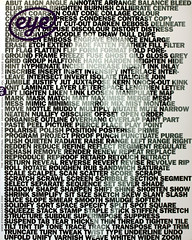Summer 2003
Luxurious frugality
An in-flight magazine for bored bourgeois bohemians. Critique by Rick Poynor
Bourgeois bohemians began their inexorable ascent in the 1960s, so maybe it’s fitting that Virgin Atlantic’s new in-flight magazine, aimed at its Upper Class passengers, is called Carlos. It’s such a late 1960s / early 1970s kind of name: Carlos Santana, Carlos Castanada, Carlos the Jackal (though terrorist associations may be less helpful here).
The magazine is certainly a 100 per cent bourgeois bohemian artefact. It will be read by people who American writer David Brooks, author of Bobos in Paradise (a ‘bobo’ is a bourgeois bohemian), describes, using the same words as Virgin, as ‘the new upper class’. Bourgeois bohemians and the companies they work for – or own – have a lot of money, but they identify with anti-establishment, counter-cultural styles rather with the old, wealthy, ruling class. It’s in their interest to have it both ways. ‘The grand achievement of the educated elites in the 1990s was to create a way of living that lets you be an affluent success and at the same time a free-spirit rebel,’ observes Brooks.
In-flight magazines occupy a funny position in the publishing firmament. Anyone with a serious desire to read will have brought along books and magazines of their own. The slightly battered reading matter in the seat-back is for flipping through in idle moments, waiting to take off or land. Some airline magazines are admittedly well written and slickly designed, but it’s hard to imagine casual browsers developing much of a loyalty. In-flight titles tend to follow dull newsstand conventions down to every last glossy detail.
Carlos, by contrast, rewrites the flight manual. The modest quarterly (measuring 170 x 240 mm) looks like one of those slim Muji notebooks with a brown card cover. For bourgeois bohemians, as Brooks has noted, roughness signifies authenticity and virtue. In an image world that delivers photographs of hallucinatory brightness and intensity at every turn, luxury is conveyed by the absence of photos. (Rem Koolhaas made a similar point when he said that in a shopping culture, ‘Luxury is not shopping’.) The only photographs in Carlos come in an eight-page Paul Smith insert by Aboud Sodano, which looks more like an art project than advertising, as the designers probably planned.
The editorial pages, art directed by Warren Jackson for John Brown Citrus Publishing, which developed the title with Virgin Atlantic, have an informal, not-trying-too-hard kind of elegance – McSweeney’s is a close cousin. All the type is printed dark blue on creamy, uncoated paper. The uppercase article intros, set in Mrs Eaves, waver eccentrically, though the columns, set in Hoefler Text, hold firm. Line drawings, another surefire sign of authenticity, feature throughout. They are often a bit artless, as in a portrait of Cameron Diaz for a drool-fest by film writer Joe Queenan. Doodles appear in the margins and sometimes drift into the text, but never to the point of distraction.
The visual mood might be quirky, even a touch enigmatic, but the content seems designed to relax and reassure. On the basis of the first issue, Carlos appears to assume that Upper Class flyers are fascinated by film, fashion and magazine publishing (which accounts for two articles). A passenger contributes an amusing list of bizarre things he has overheard said to the monkey in his laboratory. Acclaimed novelist Michel Faber writes a snooty short story about being caught in a lift with a bore. Ever wondered what Beck plays on his iPod? Well, now we know. There is a silly report on Gorgeous Networks, a dating and networking service for good-looking, successful people. One suspects that the reason for drawing this to the attention of Upper Class passengers isn’t entirely ironic.
There are few experiences that dramatise inequality as vividly as air travel. A flexible ticket in Upper Class, flying from London to New York, costs ten times more than an economy seat. While most passengers wait grimly for the ordeal to end in battery-hen conditions of questionable safety, Upper Class travellers frequent their onboard bar, book massages with the beauty therapist and stretch out in cosy sleep suits in six feet of sleeping space. Carlos, like so many products aimed at the deceptively frugal new upper class of bourgeois bohemians, is a smart idea, winningly executed. There is no obvious reason, in this case, why it couldn’t be made available to anyone on the plane who wanted a copy. Or does Virgin believe that only the wealthy have the taste to appreciate it?
As ever, culture is used as a way of bestowing privilege and drawing the boundary lines between different classes. Not so bohemian, when you think about it.
Rick Poynor, writer, founder of Eye, London
First published in Eye no. 48 vol. 12 2003
Eye is the world’s most beautiful and collectable graphic design journal, published quarterly for professional designers, students and anyone interested in critical, informed writing about graphic design and visual culture. It is available from all good design bookshops and online at the Eye shop, where you can buy subscriptions and single issues.

